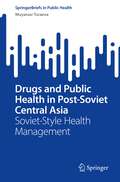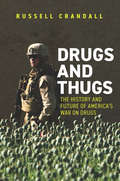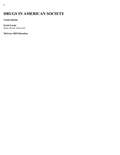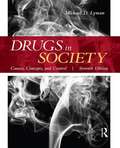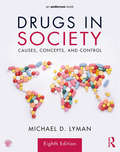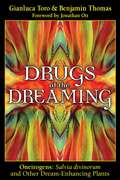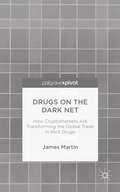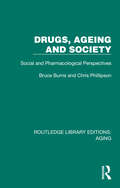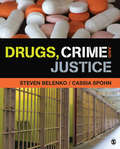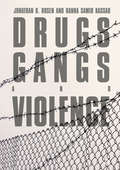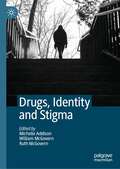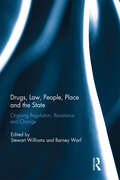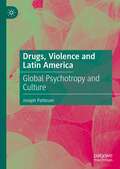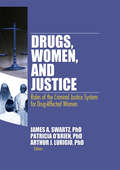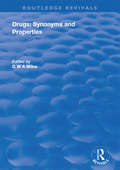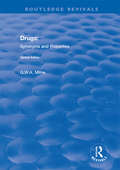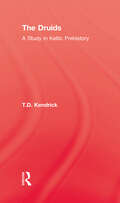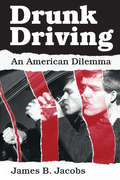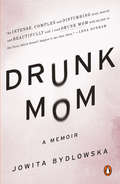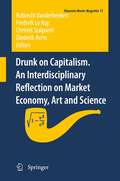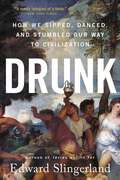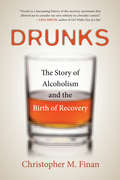- Table View
- List View
Drugs and Public Health in Post-Soviet Central Asia: Soviet-Style Health Management (SpringerBriefs in Public Health)
by Muyassar TuraevaThe book outlines post-Soviet style of health management in Central Asia. Regional studies on Central Asia to date have focused on states, politics, religion and inter-ethnic relations but not on the health system within the region. Soviet-style policies have also covered only other aspects relevant for the region. This book highlights the public health situation of the region with a focus on drug abuse, HIV/AIDS in the context of increased mobility, and drug trafficking routes which became even more porous after the break-up of the Soviet Union. Based on a qualitative study, the empirical data in the book was collected during long-term fieldwork conducted in Uzbekistan and Turkmenistan in 2010-2011 as well as shorter stays in Uzbekistan between 2012-2016. The analysis of the empirical material largely draws on the works of Foucault, particularly his concept of biopolitics when analyzing Soviet-style health management that is still practiced in the region. Applying the Foucauldian genealogical method, this study has been structured to trace the genealogy of epidemics to understand the historical path of drug abuse in the region as well as the discursive genealogy of drug politics and drug abuse. Applying the same genealogical method of Foucault, the formative and discursive trajectory of the institution of Uchyot was traced to contextualize the health governance methods that have historical legacy of Soviet-style governance and control of the total population. Drugs and Public Health in Post-Soviet Central Asia: Soviet-Style Health Management is a unique resource for academic specialists, practitioners/professionals, and advanced undergraduate and graduate students in public health, as well as a range of scholars and professionals in sociology, political science, anthropology, and anyone with an interest in the Central Asia region, drug addiction, or HIV. The book also could appeal to international donors in the field of HIV/drug addiction who are working in the region.
Drugs and Thugs: The History and Future of America's War on Drugs
by Russell C. CrandallA sweeping and highly readable work on the evolution of America&’s domestic and global drug war How can the United States chart a path forward in the war on drugs? In Drugs and Thugs, Russell Crandall uncovers the full history of this war that has lasted more than a century. As a scholar and a high-level national security advisor to both the George W. Bush and Obama administrations, he provides an essential view of the economic, political, and human impacts of U.S. drug policies. Backed by extensive research, lucid and unbiased analysis of policy, and his own personal experiences, Crandall takes readers from Afghanistan to Colombia, to Peru and Mexico, to Miami International Airport and the border crossing between El Paso and Juarez to trace the complex social networks that make up the drug trade and drug consumption. Through historically driven stories, Crandall reveals how the war on drugs has evolved to address mass incarceration, the opioid epidemic, the legalization and medical use of marijuana, and America&’s shifting foreign policy.
Drugs in American Society
by Erich GoodeDrugs in American Society is a sociological introduction to the use of psychoactive substances in the United States that takes a big-picture look at patterns of drug consumption in America while also focusing on the effects that drugs have on the lives of users. Significantly streamlined and reorganized, this tenth edition presents the most current research, data, and statistics on drug use and discusses the latest trends involving drugs, from the decriminalization and mainstreaming of marijuana to the opiate epidemic that has led to a startling rise in overdose deaths. Personal accounts of Americans that have taken drugs are provided to show the reality of drug use and provide insights that go beyond the portrayal of drugs in society and the news media.
Drugs in Society: Causes, Concepts, and Control
by Michael D. LymanThis work focuses on the many critical areas of America's drug problem, providing a foundation for rational decision making within this complex and multidisciplinary field. Broken up into three sections, Understanding the Problem, Gangs and Drugs, and Fighting Back, topics covered include the business of drugs and the role of organized crime in the drug trade, drug legalization and decriminalization, legal and law enforcement strategies, an analysis of the socialization process of drug use and abuse, and a historical discussion of drug abuse that puts the contemporary drug problem into perspective.
Drugs in Society: Causes, Concepts, and Control
by Michael D. LymanDrugs in Society: Causes, Concepts, and Control, Eighth Edition, focuses on the many critical areas of America's drug problem, providing a foundation for rational decision-making within this complex and multidisciplinary field. Lyman offers a comprehensive big-picture examination of the US drug problem, dealing with drugs, abusers, drug enforcement, and public policy. Organized in three sections: Understanding the Problem, Gangs and Drugs, and Fighting Back, topics covered include the business of drugs and the role of organized crime in the drug trade, drug legalization and decriminalization, legal and law enforcement strategies, an analysis of the socialization process of drug use and abuse, and a historical discussion of drug abuse that puts the contemporary drug problem into perspective. Suitable for upper-level undergraduates in Criminal Justice, Criminology, and related programs, Drugs in Society, Eighth Edition, uses logical organization and strong pedagogy (case studies, focused text boxes with related information, critical thinking tasks) to support learning objectives.
Drugs of the Dreaming: Salvia divinorum and Other Dream-Enhancing Plants
by Benjamin Thomas Gianluca Toro Jonathan OttThe first comprehensive guide to oneirogens--naturally occurring substances that induce and enhance dreaming • Includes extensive monographs on dream-enhancing substances derived from plant, animal, and human sources • Presents the results of scientific experiments on the effects of using oneirogens • Shows how studies in this area of ethnobotany can yield a scientific understanding of the mysterious mechanism of dreams Oneirogens are plant and animal substances that have long been used to facilitate powerful and productive dreaming. From the beginning of civilization, dreams have guided the inner and outer life of human beings both in relation to each other and to the divine. For centuries shamans have employed oneirogens in finding meaning and healing in their dreams. Drugs of the Dreaming details the properties and actions of these dream allies, establishing ethnobotanical profiles for 35 oneirogens, including those extracted from organic sources--such as Calea zacatechichi (dream herb or “leaf of the god”), Salvia divinorum, and a variety of plants from North and South America and the Pacific used in shamanic practices--as well as synthetically derived oneirogens. They explain the historical use of each oneirogen, its method of action, and what light it sheds on the scientific mechanism of dreaming. They conclude that oneirogens enhance the comprehensibility and facility of the dream/dreamer relationship and hold a powerful key for discerning the psychological needs and destinies of dreamers in the modern world.
Drugs on the Dark Net: How Cryptomarkets Are Transforming the Global Trade in Illicit Drugs
by James MartinThis study explores the rapidly expanding world of online illicit drug trading. Since the fall of the infamous Silk Road, a new generation of cryptomarkets can be found thriving on the dark net. Martin explores how these websites defy powerful law enforcement agencies and represent the new digital front in the 'war on drugs'.
Drugs, Ageing and Society: Social and Pharmacological Perspectives (Routledge Library Editions: Aging)
by Chris Phillipson Bruce BurnsDuring the 1970s and 1980s prescription and over-the-counter drugs had come to play a major role in the health care of older people. Originally published in 1986, this book reviews the historical background to this development and explores its social and pharmacological implications. The main aim of the study was to provide a critical perspective on drug use together with a framework for developing effective prescribing policies. The authors do not, in developing their arguments, reject the enormous value of drugs in the treatment of many illnesses affecting older people; they do, however, criticise excessive as well as inappropriate prescribing. The intention was to provide some practical illustrations of how the harmful effects of drug use can be curtailed. This book was aimed, in particular, at workers in the health services, for example: doctors, health visitors, district nurses, pharmacists, the professions allied to medicine. However, it should also be of interest to other groups such as social workers, carers, support groups and older people themselves.
Drugs, Crime and Public Health: The Political Economy of Drug Policy
by Alex StevensDrugs, Crime and Public Health provides an accessible but critical discussion of recent policy on illicit drugs. Using a comparative approach - centred on the UK, but with insights and complementary data gathered from the USA and other countries - it discusses theoretical perspectives and provides new empirical evidence which challenges prevalent ways of thinking about illicit drugs. It argues that problematic drug use can only be understood in the social context in which it takes place, a context which it shares with other problems of crime and public health. The book demonstrates the social and spatial overlap of these problems, examining the focus of contemporary drug policy on crime reduction. This focus, Alex Stevens contends, has made it less, rather than more, likely that long-term solutions will be produced for drugs, crime and health inequalities. And he concludes, through examining competing visions for the future of drug policy, with an argument for social solutions to these social problems.
Drugs, Crime, and Justice
by Cassia Spohn Steven R. BelenkoDrugs, Crime, and Justice is an engaging, yet comprehensive, analysis of the interrelationships among drug use/abuse, crime, and justice. The first four chapters introduce readers to the interrelationships between drugs and crime, while the second later chapters provide readers with an overview of historical and contemporary policies, as well as a comprehensive review of research on policing drug markets, arresting drug offenders, and prosecution and sentencing of drug offenders in state and federal courts. The authors also examine and assess the impact of the war on drugs and conclude with a discussion of recent policy changes such as drug courts and reform/repeal of mandatory minimum sentences and an examination of new and emerging drug policies in the 21st Century.
Drugs, Crime, and Justice
by Cassia Spohn Steven R. BelenkoDrugs, Crime, and Justice is an engaging, yet comprehensive, analysis of the interrelationships among drug use/abuse, crime, and justice. The first four chapters introduce readers to the interrelationships between drugs and crime, while the second later chapters provide readers with an overview of historical and contemporary policies, as well as a comprehensive review of research on policing drug markets, arresting drug offenders, and prosecution and sentencing of drug offenders in state and federal courts. The authors also examine and assess the impact of the war on drugs and conclude with a discussion of recent policy changes such as drug courts and reform/repeal of mandatory minimum sentences and an examination of new and emerging drug policies in the 21st Century.
Drugs, Gangs, and Violence
by Jonathan D. Rosen Hanna Samir KassabThis book examines the nature of transnational organized crime and gangs, and how these diverse organizations contribute to violence, especially in so-called fragile states across Central and Latin America. While the nature of organized crime and violence differs depending on the context, the authors explain how and why states plagued by weak institutions tend to foster criminal organizations and violence, and why counter-crime initiatives often result in higher levels of violence. By examining the consequences of tough on crime policies (e.g., mano dura) in places like Mexico, El Salvador, and Colombia, the volume offers a new perspective on the link between state fragility, crime, and violence.
Drugs, Identity and Stigma
by Michelle Addison Ruth McGovern William McGovernThis book calls attention to the impact of stigma experienced by people who use illicit drugs. Stigma is powerful: it can do untold harm to a person and place with longstanding effects. Through an exploration of themes of inequality, power, and feeling ‘out of place’ in neoliberal times, this collection focuses on how stigma is negotiated, resisted and absorbed by people who use drugs. How does stigma get under the skin? Drawing on a range of theoretical frameworks and empirical data, this book draws attention to the damaging effects stigma can have on identity, recovery, mental health, desistance from crime, and social inclusion. By connecting drug use, stigma and identity, the authors in this collection share insights into the everyday experiences of people who use drugs and add to debate focused on an agenda for social justice in drug use policy and practice.
Drugs, Law, People, Place and the State: Ongoing regulation, resistance and change
by Barney Warf Stewart WilliamsThough any psychoactive substance can be revered or reviled as a drug, as people’s cultural norms shift, ultimately its status is determined in law by the state. This publication explores the regulation of drugs – alcohol and cannabis to heroin and cocaine – and practices such as social drinking and public injecting under political regimes. Drugs are discussed in their geographical contexts: the colonial legacy of cannabis prohibition for bioprospecting in Africa; the veracity of the persistent notion of the narco-state; Turkey’s governance of drinking amid civil unrest; and alcohol’s place in the neoliberal political economy of Ireland. In addition, drug policies are examined: from problems in managing drug-related litter in the UK to supervised injecting facility provision in Australia; harm reduction in Canada; and the global network of drug policy activists. Place is significant, but porous borders, territorial overlaps and multi-scalar linkages are influential in remaking the world through current challenges to the ‘war on drugs’. This book was originally published as a special issue of Space & Polity.
Drugs, Society and Human Behavior
by Carl L. Hart Charles KsirThis book provides the latest information on drug use and its effects on society and individuals. Trusted for more than 45 years by both instructors and students, this authoritative resource examines drugs and drug use from a variety of perspectives–behavioral, pharmacological, historical, social, legal, and clinical. The 18th Edition includes the latest information and statistics on drug use trends, treatments, and drug-related mortality.
Drugs, Violence and Latin America: Global Psychotropy and Culture
by Joseph PattesonThis book undertakes a psychotropic analysis of texts that deal with the violence of drug trafficking and interdiction, especially in Mexico. While most critics of so-called narcoculture have either focused on an aesthetic “sobriety” in these works or discounted them altogether as exploitative and unworthy of serious attention, Drugs, Violence, and Latin America illuminates how such work may reflect and intervene in global networks of intoxication. Theorizing a “dialectics of intoxication” that illustrates how psychotropy may either solidify or destabilize the self and its relationship to the other, it proposes that these tendencies influence human behavior in distinct ways and are leveraged for social control within both licit and illicit economies. A consideration of a countercultural genealogy in Latin America provides a contrastive psychotropic context for contemporary novels that exposes links between narcoviolence and consumerism, challenging our addictions of thought and feeling about ourselves and our relationships to drugs and narco-violence.
Drugs, Women, and Justice: Roles of the Criminal Justice System for Drug-Affected Women
by Arthur J. Lurigio James A. Swartz Patricia O’BrienA unique interdisciplinary exploration of a pressing social issueThe numbers of women offenders involved in the correctional system are quickly growing. Drugs, Women, and Justice: Roles of the Criminal Justice System for Drug-Affected Women gathers a distinguished group of researchers and policy analysts into one volume to explore the broad social and individual implications of current policy and practice pertaining to women in the criminal justice system. This valuable resource provides readers with a superb overview of the current state of knowledge and provides recommendations for new directions. Each top-notch chapter was originally presented at the 2005 Drugs, Women, and Justice Symposium, held on the University of Illinois at Chicago campus and sponsored by the Jane Addams College of Social Work Substance Abuse Research Collaboration through a grant from the National Institute on Drug Abuse.Traditionally, criminal justice studies and rehabilitation programs have focused on male offenders. Recent studies reinforce the current evidence that females should have their needs addressed differently. This unique book presents the latest research and thinking in complex and still emerging areas of policy and treatment for women in the criminal justice system.Topics in Drugs, Women, and Justice: Roles of the Criminal Justice System for Drug-Affected Women include: characteristics of drug-involved women in the criminal justice system the negative impact on families of punitive drug laws and child welfare legislation assessing and managing the service needs of children whose mothers have been arrested influences of feelings of isolation on the course of rehabilitation demographic differences between women in drug treatment and drug-involved women in the criminal justice system service needs of women released from prison a program developed for women who have survived traumatic violence, working in the street economy, and the criminal justice system the direct and indirect impact of mass incarceration on women and more Drugs, Women, and Justice: Roles of the Criminal Justice System for Drug-Affected Women is essential reading for researchers, criminologists, sociologists, social workers, psychologists, clinicians, feminists, and policymakers in the areas of social welfare, criminal justice, and drug policy.
Drugs: Synonyms and Properties (Routledge Revivals)
by G W A MilneThis title was first published in 2000: Drugs play an important role throughout the world. In industrialized countries where a formal approval process governs the introduction of new medicinal agents, thousands of chemicals are in use as drugs. This book provides a detailed picture of this marketplace. Grouped by their medicinal use and biological activity, 8,000 drugs in common use around the world are described. For each, the chemical name and a list of trade names and synonyms are provided; the CAS Registry Number and the European Inventory of Existing Chemical Substances (EINECS) Number are given; the physical properties of each compound are described, and the known biological activity and indicated applications are presented. Indexes, including a master index of name and synonyms, are appended. This compendium should be valuable to physicians, research chemists, biologists and the lay public who, with a single synonym for a drug, will be able to quickly find a thumbnail sketch of the essential information concerning the agent
Drugs: Synonyms and Properties (Routledge Revivals)
by G W MilneThis title was first published in 2002: Drugs: Synonyms and Properties provides comprehensive coverage of the 10,000 drugs currently in common use worldwide. Its overall organization and inclusion of detailed chemical information fills an important gap in drug information. This reference, edited by a world–renowned authority in drug design and chemical information and now in its second edition, has become one of the bibles of pharmaceutical research and application. This book organizes the 10,000 drugs currently in use by therapeutic category. Therefore all tranquilizers, all antidepressants, or all anorexic agents, for example, are grouped together. In all, 204 categories are represented. This arrangement means that all drugs in a given category can be reviewed very easily and their relative properties compared quickly. A key component of this reference is the extensive coverage of synonyms. The book includes an index of over 30,000 drug synonyms and trade names with a cross–reference to their main entry. This extraordinarily comprehensive view of trade names and generic synonyms makes Drugs: Synonyms and Properties one of the world′s most exhaustive references in its field. For each main entry, the following information is provided: chemical name and a list of trade names and synonyms; the Chemical Abstracts Service (CAS) Registry Number; the European Inventory of Existing Commercial Chemical Substances (EINECS) Number; the Merck Index (Twelfth Edition) Number; the physical properties of each compound; and the known biological activity and indicated applications. Indexes, including a master index of names and synonyms, and of manufacturers and suppliers, are appended. This reference will be invaluable to research chemists, biologists, and physicians and to anyone interested in drugs who, starting with a single synonym for a drug, will be able to quickly find a thumbnail sketch of the essential information concerning that agent.
Druids
by KendrickFirst published in 2005. Routledge is an imprint of Taylor & Francis, an informa company.
Drunk Driving: An American Dilemma
by James B. JacobsIn this ambitious interdisciplinary study, James B. Jacobs provides the first comprehensive review and analysis of America's drunk driving problem and of America's anti-drunk driving policies and jurisprudence. In a clear and accessible style, he considers what has been learned, what is being done, and what constitutional limits exist to the control and enforcement of drunk driving.
Drunk Mom
by Jowita BydlowskaA bestseller in its native Canada, Drunk Mom is a gripping, brutally honest memoir of motherhood in the shadow of alcoholism Three years after giving up drinking, Jowita Bydlowska found herself throwing back a glass of champagne like it was ginger ale. It was a special occasion: a party celebrating the birth of her first child. It also marked Bydlowska's immediate, full-blown return to crippling alcoholism. In the gritty and sometimes grimly comic tradition of the bestselling memoirs Lit by Mary Karr and Smashed by Koren Zailckas, Drunk Mom is Bydlowska's account of the ways substance abuse took control of her life- the binges and blackouts, the humiliations, the extraordinary risk-taking- as well as her fight toward recovery as a young mother. This courageous memoir brilliantly shines a light on the twisted logic of an addicted mind and the powerful, transformative love of one's child. Ultimately it gives hope, especially to those struggling in the same way.
Drunk on Capitalism. An Interdisciplinary Reflection on Market Economy, Art and Science
by Christel Stalpaert Frederik Le Roy Robrecht Vanderbeeken Diederik AertsThe book presents an interdisciplinary collection of analyses that discuss the impact of market economy on our culture in the post-Berlin Wall era. It contains two parts. The first focuses on the commercialisation of science and education. The second elaborates on the multiple and diverse relation between art and capital.
Drunk: How We Sipped, Danced, and Stumbled Our Way to Civilization
by Edward SlingerlandA "entertaining and enlightening" deep dive into the alcohol-soaked origins of civilization—and the evolutionary roots of humanity&’s appetite for intoxication. (Daniel E. Lieberman, author of Exercised) While plenty of entertaining books have been written about the history of alcohol and other intoxicants, none have offered a comprehensive, convincing answer to the basic question of why humans want to get high in the first place. Drunk elegantly cuts through the tangle of urban legends and anecdotal impressions that surround our notions of intoxication to provide the first rigorous, scientifically-grounded explanation for our love of alcohol. Drawing on evidence from archaeology, history, cognitive neuroscience, psychopharmacology, social psychology, literature, and genetics, Slingerland shows that our taste for chemical intoxicants is not an evolutionary mistake, as we are so often told. In fact, intoxication helps solve a number of distinctively human challenges: enhancing creativity, alleviating stress, building trust, and pulling off the miracle of getting fiercely tribal primates to cooperate with strangers. Our desire to get drunk, along with the individual and social benefits provided by drunkenness, played a crucial role in sparking the rise of the first large-scale societies. We would not have civilization without intoxication. From marauding Vikings and bacchanalian orgies to sex-starved fruit flies, blind cave fish, and problem-solving crows, Drunk is packed with fascinating case studies and engaging science, as well as practical takeaways for individuals and communities. The result is a captivating and long overdue investigation into humanity's oldest indulgence—one that explains not only why we want to get drunk, but also how it might actually be good for us to tie one on now and then.
Drunks: An American History
by Christopher M. FinanA social history of alcoholism in the United States, from the seventeenth century to the present dayToday, millions of Americans are struggling with alcoholism, but millions are also in long-term recovery from addiction. Alcoholics Anonymous and a growing number of recovery organizations are providing support for alcoholics who will face the danger of relapse for the rest of their lives. We have finally come to understand that alcoholism is a treatable illness. But in the beginning, our nation condemned drunks for moral weakness. President John Adams renounced his alcoholic son, Charles, and refused to bury him in the family crypt.Christopher Finan reveals the history of our struggle with alcoholism and the emergence of a search for sobriety that began among Native Americans in the colonial period. He introduces us to the first of a colorful cast of characters, a remarkable Iroquois leader named Handsome Lake, a drunk who stopped drinking and dedicated his life to helping his people achieve sobriety. In the early nineteenth century, the idealistic and energetic “Washingtonians,” a group of reformed alcoholics, led the first national movement to save men like themselves. After the Civil War, doctors began to recognize that chronic drunkenness is an illness, and Dr. Leslie Keeley invented a “gold cure” that was dispensed at more than a hundred clinics around the country. But most Americans rejected a scientific explanation of alcoholism. A century after the ignominious death of Charles Adams came Carrie Nation. The wife of a drunk, she destroyed bars with a hatchet in her fury over what alcohol had done to her family. Prohibition became the law of the land, but nothing could stop the drinking.Finan also tells the dramatic story of Bill Wilson and Dr. Bob Smith, who helped each other stay sober and then created AA, which survived its tumultuous early years and finally proved that alcoholics could stay sober for a lifetime. This is narrative history at its best: entertaining and authoritative, an important portrait of one of America’s great liberation movements.
